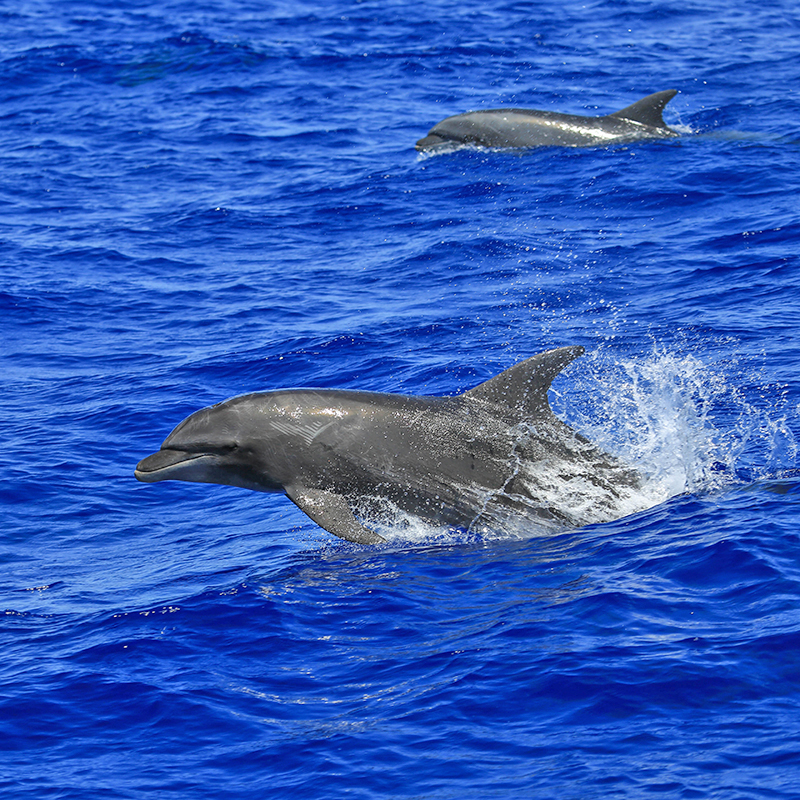Students will learn about the biology and ecology of a manatee as well as learn ways that humans impact and can protect manatees.
Lesson Plan
Cetaceans
Grade Level: 4
Students will learn about the biology and ecology of cetaceans (whales and dolphins), and learn ways that humans impact and can protect cetaceans.
Lesson files
We’d love your feedback! If you’ve used Florida Sea Grant’s educational curricula or activities, please fill out our short online evaluation.

Lessons
This curriculum provides a series of individual lessons covering cetacean (whale and dolphin) biology and ecology. The curriculum uses charismatic megafauna to engage students and inspire them to want to learn more. Lessons highlight some of the ways that humans impact and can protect cetaceans. They help teachers address science, mathematics, language arts, or visual arts objectives and could be used in place of current lesson plans for many topics. Sunshine State Standards and Common Core correlations are provided.
The first ten lessons address cetaceans in general, while the last eight lessons focus on the North Atlantic right whale. The curriculum has been written at a fourth grade level but can be adapted for older or younger students. A first grade version of the cetacean bingo activity in Lesson 3 and other resources are also provided. Lessons were used by the authors (with school groups or summer camp participants) and/or by St. Johns County (Florida) teachers. The lessons are designed to take approximately an hour unless the optional activities are incorporated. Lessons are listed in the suggested order; however, each one is a stand-alone lesson that could be taught independently of the others.
Some lessons include PowerPoint presentations. Teacher scripts for all presentations are provided in the lessons, as are answer keys for student worksheets.
Reading & Instructional Materials
Students will learn about cetaceans by reading the book, The Great Whale Watch. Students will keep a reading journal.
Reading & Instructional Materials:
Students will learn about general whale and dolphin biology and will use their knowledge of new vocabulary to complete a vocabulary worksheet.
Reading & Instructional Materials:
Students will play a modified game of Bingo to learn about individual cetacean species.
Reading & Instructional Materials:
- Lesson 3: Researching Individual Whale & Dolphin Species
- Download Bingo List 1 PowerPoint
- Download Bingo List 2 PowerPoint
Modified Materials/Activities for Grades 1-2:
Students will show the lengths of difference cetaceans using a “whale-o-meter.” Math activities include creating a life-size drawing of a cetacean and estimating the weight of an orca at different ages.
Reading & Instructional Materials:
- Lesson 4: How Big Are Cetaceans?
- Activities utilize fact sheets from Lesson 3: Researching Individual Whale & Dolphin Species
Students will use Greek and Latin roots to interpret the scientific names of some whales. They will create a hypothetical cetacean and give it an appropriate scientific name.
Reading & Instructional Materials:
Students will learn about behaviors that many whales can be seen doing. They will make whale puppets and use them to model different whale behaviors.
Reading & Instructional Materials:
Students will learn about the dfifferences between how baleen and toothed whales feed. Students will learn how sound waves are used for echolocation.
Reading & Instructional Materials:
Students will learn about food chains and conduct a food chain activity.
Reading & Instructional Materials:
Students will investigate the roles that insulation (blubber) and body shape play in preventing heat loss in marine mammals.
Reading & Instructional Materials:
Students will learn about different types of poetry and will write poems to express what they know about whales and dolphins.
Reading & Instructional Materials:
Students will learn about NARW life histories by using resource materials to complete worksheets.
Reading & Instructional Materials:
Students will learn about the New England Aquarium’s right whale database and will try to match photographs to drawings of individual right whales.
Reading & Instructional Materials:
Students will learn about right whale migration and ways that right whales are being studied.
Reading & Instructional Materials:
Students will learn how baleen whales use sound to communicate and how human-created noises in the ocean may affect them. Students will conduct an activity to simulate whale communication and interference by human noise.
Reading & Instructional Materials:
Students will learn about the ways that technology is being used to study North Atlantic right whales.
Reading & Instructional Materials:
Students will learn why ship strikes are a threat to North Atlantic right whales and what conservation measures are in place to reduce this threat.
Reading & Instructional Materials:
Students will learn about ways to minimize ship strikes and whale entanglements. Students will explore ways that they as individuals can help protect North Atlantic right whales.
Reading & Instructional Materials:
Students will develop a persuasive essay about the need to protect right whales, and will give a presentation based on the essay.
Reading & Instructional Materials:
- Whales: Activities Based On Research from the Center for Coastal Studies
Posted with permission from Scholastic and the Center for Coastal Studies - North Atlantic Right Whale Coloring Book
Posted with permission of GA Ports Authority - Ocean Conservancy’s Right Whale Information Book (elementary age)
- NOAA’s Right Whale Fortune Teller
- Face-ing Extinction: The North Atlantic Right Whale
Cetacean Education Videos
Adapted for individual learning
Cetacean Education Videos
Acknowledgements
This curriculum was designed in 2011-2012 by Drs. Maia McGuire and Ruth Francis-Floyd and was reviewed in 2013 by Cheryl Bonnes and NOAA’s right whale SouthEast Implementation Team. Brenda Cannaliato contributed to lessons 8, 12 and 16. All lessons were revised and updated in 2019. Sunshine State Standards (science) and/or common core standards are provided for each of the lessons. The authors thank the Florida Fish and Wildlife Conservation Commission for their financial support of this project, and Kathy McLaughlin for pilot-testing several of the lessons.
Explore More Lesson Plans
Students will learn about the biology and ecology of sea turtles and the ways that humans impact and can protect them.